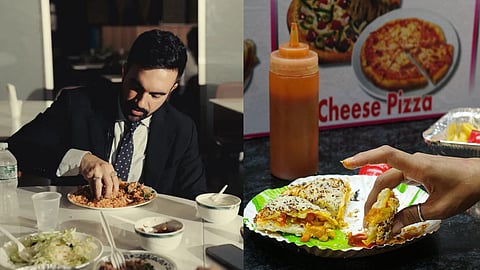
- HOMEGROWN WORLD
- #HGCREATORS
- #HGEXPLORE
- #HGVOICES
- #HGSHOP
- CAREERS
- ABOUT US
- CONTACT US

While undoubtedly Zohran Mamdani’s campaign is one for the books — a case study in itself — there was a moment captured during his trail that, though seemingly mundane to us South Asians, caused quite an uproar. The media was shocked and even disgusted. Some called it strange and barbaric; others said that if someone in their family did something like that, they’d be disowned. And what was this moment, you ask?
It was Mr. Mamdani — the son of an Indian mother and a Ugandan-Indian father — eating biryani with, wait for it, his hands. No spoon, no fork — just diving into the rice hand-first.
Eating with your hands is an age-old practice, one that dates back to Egyptian and Greek civilisations. In India, this practice is deeply tied to Ayurvedic philosophy, where food isn’t just nourishment but an offering — one that engages all five senses. The act of touch is believed to stimulate digestive enzymes and signal to the body that it’s time to eat. Accordingt to this philosophy, each finger represents an element — earth, water, fire, air, and space — making the process of eating an embodied ritual of balance and mindfulness. The act of eating, therefore, was never meant to be mechanical; it was meant to be mindful.
But somewhere along the way, colonisation stripped that gesture of its dignity. The fork and knife became symbols of 'refinement', and anything that didn’t fit the Western version dining etiquette was deemed crude or uncivilized. Ironically, the same cultures that tut-tut at hand-eating see no problem with eating burgers, sandwiches, or pizza with their bare fingers. The difference, it seems, isn’t the method but the culture. Their bread over our rice.
In India, the habit of eating with your hands is layered with class and caste undertones. What was once an equalizer — every hand meeting the meal — became a marker of social distinction. Eating with one’s hands became 'messy', 'unsophisticated', and 'uncouth', while cutlery became a shorthand for education, and upward mobility. In a country where touch and ‘purity’ are often weaponised to enforce social boundaries, eating with our hands is also tied deeply to the politics of space. Going to an upscale fine-dining establishment? Knives and forks. Eating dal-chawal at home? The hand. These distinctions reveal how class and taste have been carefully curated into our dining habits. It’s not just about what we eat, but where and how we eat it. Funnily enough, there are some social settings where asking for cutlery would be considered disrespectful — my grandma's home when she's made rasam-rice and any South Indian celebration.
I remember growing up sitting at the adult dinner table, and being told the etiquette of eating with my hand, how the sign of a respectable and good eater was always full fingers and a clean palm. Now there is nothing wrong with using cutlery, in some cases it is the better option, but there is something about eating with your hands, and being able to feel the food that will fuel you, that makes the whole experience so romantic. In the grand scheme of things, it's a small gesture, but food is at the centre of most socio-cultural conversations and even though Zoran's win is thousands of kilometres away from us, the ripples of the conversations had on South Asian cultural practices can be felt oceans away. And that makes us wonder that if New York can accept a mayor who eats with his hands, then why can't we?
